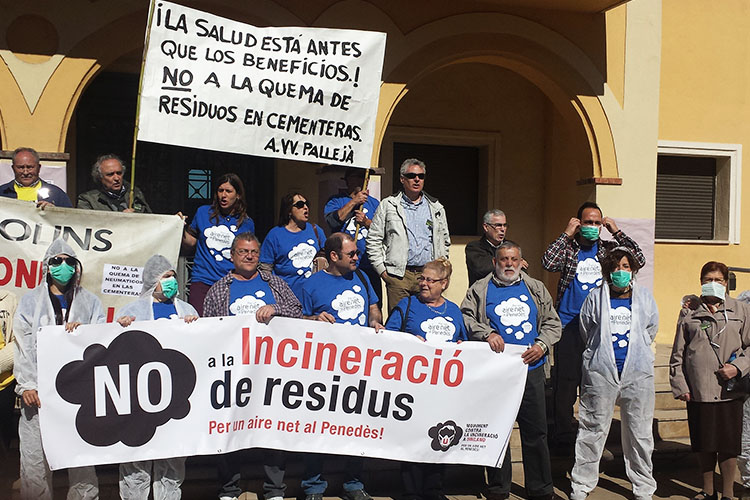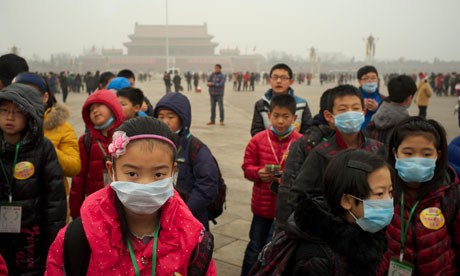Toxicology
“Normal Levels” of Air Pollution Increase Risk of Dementia
 Supporters who saw us out and about for Earth Day events could come by the table and pick up a new flyer of ours that cites at least four recent studies linking dirty air to Autism and other developmental disorders in children.
Supporters who saw us out and about for Earth Day events could come by the table and pick up a new flyer of ours that cites at least four recent studies linking dirty air to Autism and other developmental disorders in children.
Now comes a study that suggests the other end of the age spectrum is also adversely affected by the same phenomenon – that the brains of middle aged and older adults are subject to accelerated aging from exposure to "normal levels" of particulate matter (PM) air pollution in cities.
Writing in the May issue of "Stroke," researchers with the Cardiovascular Epidemiology Research Unit of Beth Israel Deaconess Medical Center in Boston described the results of a long term study of more than 943 men and women at least 60 years old and free of dementia and stroke histories. Those subjects living near "major roads" and exposed to "normal pollution levels" suffered cerebral shrinkage, ageing their brains by the equivalent of one year, and increasing their dementia risk. Small increases in particulate matter (PM) air pollution – an increase of only two microgram per cubic meter of air was sufficient to increase the risks.
"Exposure to elevated levels of PM2.5 was associated with smaller total cerebral brain volume, a marker of age-associated brain atrophy, and with higher odds of covert brain infarcts. These findings suggest that air pollution is associated with insidious effects on structural brain aging even in dementia- and stroke-free persons. "
Researchers said the exact causality was unclear, but that it might be that inflammation as a result of the deposit of fine particles in the lungs resulted in the increase in risk.
PM pollution is microscopic particles of soot – 1000th of the width of a human hair – emitted by combustion of all types: gasoline and diesel engines in vehicles, as well as boilers and furnaces in cement kilns, power plants and flares. PM 2. 5 refers to the size of the particle – at least 2.5 microns or smaller. The larger the road, the more traffic, the more internal combustion engines pass by releasing their PM pollution. Other studies – including the ones on our Autism flyers – have found a relationship between proximity to roads and brain disorders in children.
Professor of Neurology Dr Sudha Seshadri at Boston University School of Medicine said: "On average participants who lived in more polluted areas had the brain volume of someone a year older than participants who lived in less polluted areas." They also had a 46 per cent higher risk of silent strokes. "This is concerning since we know that silent strokes increase the risk of overt strokes and of developing dementia, walking problems and depression.”
Last year researchers suggested that commuters could cut their air pollution intake in half simply by using the side streets in major cities rather than main roads.
Dr Rossa Brugha, a paediatrician and pollution researcher at Queen Mary, University of London, said walkers and runners can make small adjustments to their route which could have major benefits on their health.
With the growing body of evidence that proximity to heavy traffic is detrimental to public health, the siting of new housing and schools should also be impacted by urban planners and developers, as well as give momentum to those who want to re-examine the need for large highway projects in densely-populated areas.
Spanish Study: Link Between Cement Kilns and Cancer
 Although it was first published last July, news of a new Spanish epidemiological study of residents living in proximity to cement plants has just now reached us.
Although it was first published last July, news of a new Spanish epidemiological study of residents living in proximity to cement plants has just now reached us.
Done by the the same researchers responsible for a 2012 study that found statistically significant increases in all cancers around waste incineration and auto scrap metal operation, this more recent report focuses just on cement, lime and plaster plants.
According to the researchers, a statistically signifiant increase in all cancer mortality was detected in the vicinity of these installations as a whole, but principally, in the vicinity of cement installations. Specifically, tumors of the colon–rectum in both sexes and of the pleura peritoneum, gallbladder, bladder and stomach in men were noticably higher. In a summary of the results, the authors state they believe residents have "an excess risk of dying from cancer, especially in colon–rectum, in towns near these industries."
Because they take such a long time and so much effort, there's a dearth of epidemiological studies focused entirely on cancer risks among those living in proximity to cement plants, although a 2004 Italian study found a significantly greater risk of lung cancer among people living near a cement factory (whereas the results of another Italian study confirmed significant excesses for cancers like the nervous system, leukemia, mesothelioma and peritoneum in a region with the presence of various industries including cement factories.
In explaining the higher incidence of gut cancers among both men and women, the study hypothesizes about the possible ways local residents are exposed to carcinogens:
In our study, one aspect to be borne in mind is that colorectal
cancer is the only tumor with statistically significant excess risks
in men and women, which might be indicative of a pathway of
environmental exposure. In this case, two possible routes of exposure
to the pollution released by these installations are considered:
direct exposure to pollutants released to air; and indirect exposure,
both to pollutants and liquid effluents which are released to water
and can then pass into the soil and aquifers, and pollutants which
are released to air and then settle on plants. In such cases, the toxins
may pass into the trophic chain, affecting the population.Some authors have already shown associations between colorectal cancer and proximity to industrial pollution sources as metal industries (Garcia-Perez et al., 2010), mining (Fernandez-Navarro et al.,2012), food and beverage sector (Lopez-Abente et al., 2012) andchemical plants (Wilkinson et al., 1997). As regards cement plants,
a Brazilian study found a significant elevation on colorectal cancer
mortality in an industrialized area with cement industries came
into operation in the 1960s, among other facilities (Medrado-
Faria et al., 2001), and a Korean occupational study suggested a
potential association between exposure in the cement industry
and an increased risk of rectal cancer (Koh et al., 2013).
One thing a lot of these overseas studies and the Midlothian area have in common is a concentration of heavy industry. There's usually more than one facility and the region is considered an industrial corridor. That's certainly true of Midlothian, where besides hosting three large cement plants, the town is also home to a huge secondary steel mill, a power plant, and now an LNG plant. These industries combine to present a multitude of possible synergestic combinations of toxins to anyone living adjacent to, or downwind of them. "Toxic soup" is a term often used to describe the result.
This is also why the law lags behind the science in setting standards for cause and effect. When it's the cascade of chemicals from various facilities assaulting you, you're rarely going to be able to link a particular disease or illness with a specific plant. And yet the harm is happening all the same. This is why institutionalizing the "Precautionary Principle" into public policy is so important. It's much easier to prevent a chemical exposure than to track all of its ill effects after it's already doing damage.
Even a Single Day of Air Pollution Increases Stroke Risk
 When environmental health advocates speak about the dangers of dirty air, the effects are often categorized as long term and cumulative. But the more scientists delve into the subtleties of the human body and what outside influences can do it, the more they realize that even short term exposures can be harmful. That's been especially true lately when looking at pregnant moms and the exposure to fetuses in certain stages of development. Not it turns out to true when looking at the other end of the age spectrum.
When environmental health advocates speak about the dangers of dirty air, the effects are often categorized as long term and cumulative. But the more scientists delve into the subtleties of the human body and what outside influences can do it, the more they realize that even short term exposures can be harmful. That's been especially true lately when looking at pregnant moms and the exposure to fetuses in certain stages of development. Not it turns out to true when looking at the other end of the age spectrum.
A new examination of 103 studies involving 6.2 million stroke hospitalizations and deaths in 28 countries published online at the BMJ (British Medical Journal) found that almost every type of industrial air pollution contributed to a higher risk of stroke. And the higher level of exposure to the pollutant, the higher the risk of stroke.
Increases in the levels of Nitrogen Dioxide, Sulfur Dioxide, Carbon Monoxide and fine Particulate Matter were all associated with increases in strikes and hospitalizations. Not surprisingly, the strongest correlations were on the day of actual exposure, but the effects of PM, otherwise known as soot, were longer lasting. Missing from the list is ozone, or plain old smog, which studies have shown increases asthma and heart attacks on its own.
According to the report, strokes account for five million deaths worldwide every year and cause en even greater number of disabilities.
The lead author, Dr. Anoop Shah, from the University of Edinburgh, said that there was little an individual can do when there's a bad air day going on but stay indoors
“If you’re elderly, or have co-morbid conditions, you should stay inside,” he said. But policies leading to cleaner air would have the greatest impact, he said. “It’s a question of getting cities and countries to change.”
Are Environmental Causes Behind a “Pandemic” of Child Brain Disorders?
 Anecdotally you may have heard commentary from a friend about the large numbers of kids in their child's age group who seem to have something wrong with their brain – ADHD or Autism for example. Turns out, there's some solid statistical evidence those conditions are on the rise.
Anecdotally you may have heard commentary from a friend about the large numbers of kids in their child's age group who seem to have something wrong with their brain – ADHD or Autism for example. Turns out, there's some solid statistical evidence those conditions are on the rise.
According to the U.S. Centers for Disease Control, almost two million more children in the U.S. were diagnosed with developmental disabilities in the mid-Oughts than in the mid-1990's. This same decade saw autism climb nearly 300 percent, while that of attention deficit hyperactivity disorder increased 33 percent.
In total, the CDC concludes that 10-15 percent of kids born in America have some type of "neurobehavorial development disorder" and many more were have milder afflictions that don't necessarily rise (yet) to the level of an official diagnosis. These rising numbers are why some leading researchers are saying we're experiencing a "pandemic" level of child brain disorders.
Genetics are believed to account for as much as 30-40 percent of that increase (whether it's genetics or "epigenetics" isn't examined). However, study after recent study also suggests that environmental exposures play a significant role.
Last month, Journalist Elizabeth Grossman wrote about the insidious impact of toxins on the brains of children, either while they're still in the womb or in their early years as their brains are still developing. She describes both indoor and outdoor exposure pathways that offer a multitude of opportunities for kids or pregnant mothers to be exposed to chemicals that can have both subtle and profound impacts on brain behavior.
There are the bad ones we know so much about but can't seem to eliminate from the marketplace, like lead, that still turns up in plastic "softeners" and imported paints. But there's also the threat that grows from fine particulate matter with almost every new research effort published, as well as more ubiquitous chemicals used in fire retardants (PBDEs) plastics (BPA and phthalates), and "perfluorinated compounds" used in stain resistant coatings and pesticides.
Only since the 1980's have scientists realized how much more vulnerable the brains, and hormones, of kids are to the impact of toxins. Even "low levels" of exposures at the wrong time in fetal development can have big consequences. One research is quoted by Grossman as saying that "timing determines destination."
In terms of air pollution, there are now numerous studies linking Particulate Matter (PM) pollution to Autism, including one published as recently as December from the Harvard School of Public Health showing that mothers exposed to high levels of the pollution were twice as likely to give birth to children diagnosed with the disorder.
Pregnant moms exposed to high levels of Polycyclic Aromatic Hydrocarbons, or PAHs – another by-product of burning stuff – were five times more likely to raise children with Attention Deficit Hyperactivity Disorder according to a recent study published by Columbia University's Mailman School of Public Health.
When you combine these air pollution threats with the retardants on the furniture we buy, the residues of pesticides on the food we eat, and the plastics we eat and drink from, the world looks like a very hostile place for developing minds.
No matter the exposure pathway, the problem is the old familiar one of an outdated and slow-moving regulatory system dealing with a marketplace where thousands of new chemicals are introduced without proper health screenings for fundamentals like cancer, much less their more subtle impacts on children's brain development. The ability for chemicals to cause harm is outracing the mechanism in place to prevent them. We're still reacting to being poisoned instead of being proactive about preventing it.
Study: Less Smog Means Healthier Kids
 Up to this point almost all studies about air pollution have tracked increasing levels of air pollution with decreasing levels of health. Respiratory problems, strokes, heart disease, Autism, Parkinson's-like symptoms – they've all been linked to exposure to high levels of air pollution vs exposure to less severe air pollution.
Up to this point almost all studies about air pollution have tracked increasing levels of air pollution with decreasing levels of health. Respiratory problems, strokes, heart disease, Autism, Parkinson's-like symptoms – they've all been linked to exposure to high levels of air pollution vs exposure to less severe air pollution.
Now, comes a new study that approaches the problem from the opposite end of things. It associates healthier kids, specifically, increased lung capacity, with cleaner air over time in Southern California. It provides much needed evidence that pollution controls mandated by the Clean Air Act over the last 40 years have had their intended effect and improved public health.
On Wednesday, the results of the effort were published in the New England Journal of Medicine by researchers from the Keck School of Medicine at the University of Southern California (USC).
Over two decades, researchers at USC studied air pollution levels as they declined in five smog-plagued local communities, while also measuring breathing capacity in 2,120 school children from those same communities during three separate time periods: 1994-1998, 1997-2001 and 2007-2011.
The last group of kids tested showed improved lung growth of about 10% between the ages of 11 and 15, compared with children at the same age in 1996. Overall, the percentage of children with abnormally low lung function at age 15 dropped from nearly 8% in 1994-98, to 6.3% in 1997-2001, to just 3.6% in 2007-11. The positive effects were observed in boys and girls, and regardless of race and ethnicity.
This increase in lung function tracks with improvements in air quality in the LA Basin. According to the ALA, despite a higher population and more cars, Los Angeles had 68 fewer high-ozone days last year than in 1996, and 75 fewer high-particulate-matter days than in 2000. By the study’s conclusion in 2011, fine particulates had fallen by 50 percent and nitrogen dioxide levels by 35 percent in the communities being studied.
Those communities had fewer bad air days because of the pollution controls introduced by government beginning in the mid 1970's with the introduction of the automobile catalytic converter, and continuing to this day with emissions restrictions on everything from shipyards to power plants to lawn mowers.
According to the USC study, those controls and the decrease in smog they produced, have led to fewer stunted lungs and fewer children susceptible to asthma and a host of other respiratory disorders.
According to USC's James Gauderman,
“Improved air quality over the past 20 years has helped reduce the gap in lung health for kids inside, versus outside, the LA basin.”
Consensus in the scientific community (outside TCEQ) seems to suggest that this kind of study wil be important in proving the efficacy of new pollution controls across the country.
Morton Lippmann, a professor of environmental medicine at New York University School of Medicine, said the research would be influential and predicted that within the next few years, when federal emission standards are due for review, “this kind of information will play a major role.”
“It provides confirmation that the work we’ve done to improve air pollution has made a difference in kids’ health,” said Dr. Joel Kaufman, a physician and epidemiologist at the University of Washington, who was not involved in the research. “There are more kids comfortable running around.”
The caveat here is that while new controls benefited public health, it was not necessarily the controls on ozone pollution alone that caused the benefits. During the two decades of study, ozone levels declined only modestly. Ozone has been associated with acute health problems, such as asthma attacks, but the researchers concluded that its reduction does not have the long-term effects on overall lung function that reductions in fine particulates and nitrogen dioxide do.
Pollution controls for ozone, or smog, often have the side effect of reducing particulate matter (PM) and NO2 (one of the forms of Nitrogen Oxide that form ozone), as well. It may well be that these side effects have more impact on public health than previously believed. Certainly the accumulating evidence about the variety of insidious harms caused by even low levels of particulate matter exposure give credence to this idea. Based on the scientific literature, many local downwinders have believed that the single most dangerous kind of pollution being emitted by the cement plants in Midlothian are their voluminous amounts of PM pollution.
One of the reasons Downwinders at Risk has been so insistent on getting Selective Catalytic Reduction (SCR) on the kilns is that, besides being able to reduce NOX pollution by 80-90 % or more, the equipment is also able to make sizable dents in Dioxins, Volatile Organic Compounds, and yes, Particulate Matter pollution.
The Chinese Silent Spring Moment?
 Every once in a while, even now, in the midst of our electronic surroundsound calliope, popular culture can freeze on a moment of some social significance that strikes a collective nerve. For the US this summer it was Ferguson, Missouri. For China, it might just be this last weekend's debut of a documentary about the horrible air pollution that envelopes life in much of that country.
Every once in a while, even now, in the midst of our electronic surroundsound calliope, popular culture can freeze on a moment of some social significance that strikes a collective nerve. For the US this summer it was Ferguson, Missouri. For China, it might just be this last weekend's debut of a documentary about the horrible air pollution that envelopes life in much of that country.
"Under the Dome" is the video manifesto of a Chai Jing, a former Chinese television reporter who didn't give much thought to the brown haze she was breathing, until she was breathing for two.
"Back then, she says, she paid little attention to the smog engulfing much of China and affecting 600 million people, even as her work took her to places where the air was acrid with fumes and dust.
“But,” Ms. Chai says with a pause, “when I returned to Beijing, I learned that I was pregnant."
“I’d never felt afraid of pollution before, and never wore a mask no matter where,” Ms. Chai, 39, says in the video. “But when you carry a life in you, what she breathes, eats and drinks are all your responsibility, and then you feel the fear.”
Her film was posted online Saturday and within just a news cycle or two caused such an uproar and reaction that China's minister of environmental protection compared it to Rachel Carson's “Silent Spring,” the landmark exposé of chemical pollution published in the early 1960's that led to the banning of DDT in the United States. By Sunday afternoon, over 25,000 comments from Chinese citizens had been left at her website, including ones like this that any frustrated downwinder can relate to: “In this messed-up country that’s devoid of law, cold-hearted, numb and arrogant, (her film) is like an eye-grabbing sign that shocks the soul.”
Jing's approach to the material is partly responsible. This isn't a detached observational third-person narrative of the problem. It's her own memoir that uses science and investigative reporting as tools to explore the links between her daughter's benign tumor and the dirty air she believes might have caused it, and so many other health problems. It;s a personal story she probably ould not have told as a member of the official Chinese television news network where she was employed for many years.
We've noted for some time that the most radical environmentalists on the planet aren't Earth Firsters in Colorado, or Greenpeace activists in Europe, but angry Chinese parents, who, over the last decade, have kidnapped the managers of polluting facilities and destroyed whole chemical plants suspected of causing widespread health problems in villages. Undistracted by a mind-numbing, soul-killing regulatory regime like the Texas Commission on Environmental Quality that offers a veneer of control, there's no bureaucratic weapons available to most Chinese citizens when they're being shat on by industry. You either accept it or you don't. Increasingly, when it comes to the harm being imposed on their children, many don't. Especially the mothers.
Take a look at the membership of any front line environmental group. It's populated and administered mostly by women. It was women like Rachel Carson who took on the patriarchy of "modern science" to begin the discussion on environmental health. It was Los Angeles moms in the 1950's who organized the first anti-smog groups and began the modern fight for cleaner air. It was Lois Gibbs, the mother, at Love Canal who committed her own act of kidnapping when she found out her house was built on top of a toxic waste dump. It's women who lead the anti-fracking groups around the country today and here in the Barnett Shale. It's women who founded and make up 90% of Downwinders' board.
Environmental activism may be one of the purest forms of modern feminism there is, both in content and organization. And it's a woman, a mother, who may have once again held up a mirror to a culture, one that hosts a full 6th of the world's population, and asked what the hell are we doing to our species by exposing ourselves to so many obvious poisons.
Worried Much? Gas Industry Desperate to Hold Back Truth and Mansfield Ordinance Reform
 For almost a year, Mansfield residents have been trying to rewrite their city's drilling ordinance to better reflect the science surrounding the public health consequences of heavy industry taking place so close to people. During this entire time, and countless appearances before their city council, there has not been one Mansfield citizen who came forward and defended the current approach.
For almost a year, Mansfield residents have been trying to rewrite their city's drilling ordinance to better reflect the science surrounding the public health consequences of heavy industry taking place so close to people. During this entire time, and countless appearances before their city council, there has not been one Mansfield citizen who came forward and defended the current approach.
But now that the Mansfield council is ready to act on a new ordinance, the gas industry is doing exactly what it's always accusing their opponents of doing, sending outsiders in to invade the town and spread misleading information. And they're doing it in a big, desperate way. Let's just review what's happened in the last couple of weeks:
Industry hired a sleazy push polling firm to conduct a Mansfield campaign by phone that purposely misleads about the impact of the revisions to the ordinance being sought and makes personal attacks on the residents pursuing those revisions.
Sent in trade association speakers from Austin and Fort Worth to Mansfield to further mislead the business community about the revisions being sought.
Set up an e-mail site where industry employees, no matter where they live, send their comments to the Mansfield City Council, in opposition to any revisions.
And last night, (Sunday) the industry released a "study" purporting to show how safe the existing 600 foot setback was in Mansfield.
And these are just the things we know about right now. Having seen the huge multi-well Edge Resources permit get temporarily, but unexpectedly, tabled in January, the industry wasn't about to take any chances on seeing that happening again in their own back yard. So they've thrown everything and the kitchen sink into the Mansfield fight.
Of course, this reaction is a tremendous complement to the efforts of the intrepid Mansfield Gas Well Awareness group, that has, oh who knows, maybe a millionth of the budget the industry has already spent on these efforts. That the gas industry should be so frightened by calls for "responsible drilling" and more protective measures that have numerous precedents in the region tells you all you need to know about their insecurity post-Denton. It's almost comical.
Let's just take the latest effort that the Energy in Depth guys are generously calling a "study." Forget that if an environmental group were offering up such a thing, they'd be the first to point out its obvious bias. But of course, that objection disappears entirely when they fund the results. All of a sudden its a paragon of virtuous objective science. And mind you, these results were funded by the very gas operator who's well emissions are being sampled. No conflict of interest there.
Forget also that they're so proud of this work that they released it on a Sunday, after hours, the day before the Mansfield City Council takes up consideration of a new gas drilling ordinance. It's almost like they wanted to minimize the scrutiny of the thing.
Also put aside that this thing is not peer-reviewed or journal published – because the "science" is so poorly done that it could never pass review and get published in anything but an Energy In Depth blog post.
Also discount the love industry has for for testing levels of contaminants in the air versus its utter contempt for testing people and health. If you're going to claim as your working hypothesis that certain levels of contamination are completely harmless, and that anything that falls below certain levels is benign, then why not put that hypothesis to the test by performing an epidemiological study? But no, you see no such studies coming from industry, because they don't want to test that hypothesis.
One type of study is top, down. It looks at the levels of poisons in the air, and assumes that if they don't exceed the levels deemed dangerous by the regulatory arm of the industry , the Texas Commission on Environmental Quality, then everything must be hunky dory.
The other is bottom-up. It looks at the health of people who live adjacent to the facility releasing the poisons and determines whether their health is worse than those who don't live in close proximity to polluters, whether they are receiving officially sanctioned levels of poisons are not.
The reason the second type of study is a truer snapshot of reality is because we keep finding out that levels of poisons we thought were safe turn out not to be safe at all. Go back even 20 years to the Exide lead smelter in Frisco, or 30 years to the RSR lead smelter in Dallas. Regulators and industry were routinely saying that levels of lead being released by these facilities were "safe." As it turns out, they were not. In fact, science now says there's no level of exposure to lead that cannot do harm to a person, particularly a child.
This learning curve can be applied to many, many types of chemical exposures over the last few decades, including Benzene, and other poisons routinely released by the gas industry. And it's why industry never wants to test its hypothesis about "safe" levels of things in the air with studies of what the actual health of people who live near their facilities is really like.
In reality, the best epidemiological studies to date, those that ARE done by third parties and ARE peer-reviewed an journal published, all conclude that living near gas mining operations increases the likelihood that you'll get sick. That's the state of the science. It's the same kind of science that proved cigarette smoking causes cancer. And that's why industry wants to stick to telling you about how safe the levels of poisons are in the air.
But forget all of that. Let's just take this "study" thing at face value. There was a 100 minutes of sampling of the air in 2012 at a gas pad site before drilling started, and in 2014, there were three 30 minute samplings of air around 600 feet away from the pad site after drilling had begun, and one sampling site well away from the pad to function as a background reading. That's it. That's the entirety of the study: the comparison of this "before" and "after" short term sampling.
Now if you were a high school chemistry nerd looking for a shot in the local science fair, you might insist that the procedures and testing protocol be the same for the before and after sampling. And you'd be right. But this study didn't bother.
In 2012, the sampling looked at Volatile Organic Compounds (VOCs), Sulfur Compounds and Formaldehyde "and other Carbonyl Compounds." In 2014, the sampling only looked at VOCs. so, only one-third of the original 2012 testing was duplicated. You'd think they were trying to intentionally ignore some poisons or something.
But it gets better. There were 15 separate VOCs sampled for in 2012, but only six, (less than half and only barely more than a third), of those were sampled for in 2014. In other words, the 2014 sampling not only left out two-thirds of the 2012 contaminant categories, it left out most of the chemicals in the one category it did sample.
In 2012, you had a total of 100 minutes of sampling of air in the middle of the pad site. In 2014, you had three 30-minute samplings of air 600 feet away from the pad site. They couldn't even replicate the sampling time.
As Texas Sharon has already pointed out, you might want to do your sampling with the same general kinds of weather – circumstances that might promise a representative sample. But no, not for this "study." There was only a trace of rain recorded at the site in 2012, but between half an inch of rain and two and a half inches of rain in the 2014 sampling. Of course, rain being in the air and all, that could affect your air sampling results.
The average wind speed was 6 to 11 mph in 2012, while in 2014, it was, well, the second report really doesn't say what the average wind speed was. It just says that the wind speed varied from 0 to 21 along with wind direction. But who needs details for real science right?
In 2014, none of the background samples were the highest levels of exposure found, that is, the highest readings of all chemicals found were downwind of the pad site.
Of the six VOCs sampled for in both 2012, and 2014, three were significantly higher in 2014.
Benzene was almost 4 times higher in 2014: .13 vs .49.
Toluene was almost three times higher in 2014: .35 vs .91.
Methyl Ethyl Ketones increased by a third: from .53 to .72.
And mind you this was in the rain with gusts up to 21 mph. Only m,p Xylene and Carbon Disulfide were lower in 2014.
In all, these chemicals were detected despite the crappy methodology used:
- Benzene
- Benzene, 1,2,4‐trimethyl‐
- Benzene, 1,3,5‐trimethyl‐
- Benzene, 1,3‐dichloro‐
- Benzene, 1,4‐dichloro‐
- Carbon disulfide
- Carbon Tetrachloride
- Cyclohexane
- Ethane, 1,1,2,2‐tetrachloro‐
- Ethane, 1,1,2‐trichloro‐1,2,2‐trifluoro‐ (Freon 113)
- Ethylbenzene
- Furan, tetrahydro‐
- Heptane
- Methyl Butyl Ketone (MBK)
- Methyl Ethyl Ketone (MEK)
- Methyl Isobutyl Ketone (MIBK)
- Methyl Methacrylate
- Methylene Chloride
- Naphthalene
- o‐Xylene
- m,p‐Xylene
- Styrene
- Tetrachloroethylene
- Toluene
- Trichloroethylene
- Trichloromonofluoromethane (Freon 11)
That's reassuring right? That's what the industry folks are saying, because guess what, they're all at levels below what TCEQ says are OK for you to breathe – for a total of 30 minutes per sample. Unfortunately, most of us have a hard time breaking our habit of breathing all the time. Everyday. For years on end.
Look, you don't need to be a scientist to know how full of holes this slap dash attempt at CYA actually is. Industry is just throwing one thing after another up on the wall and hoping it sticks for the time it takes for the Mansfield City Council to justify its rejection of the citizens' revisions. Especially the 1500 setback originally requested.
Industry keeps saying that this distance amounts to a "defacto" ban of drilling, but that's clearly not the case in Mansfield. It's own literature touts the fact that a rig can be more than a mile away from the gas deposit its mining. You can put a rig in an industrial zoning tract and still reach a pocket of gas underneath a neighborhood without the surface components being anywhere near each other.
So what's the real reason industry oppose these setbacks for heavy industry that would be more than appropriate for any other kind of heavy industry? It's because the gas industry doesn't want to be grouped with lead smelters, and cement plants, and refineries and other kinds of heavy industry. It operates under an industrial exceptionalism that's unique in the modern era. It wants to be viewed as the kindly, well-landscaped heavy industrial polluter. Because when you start seeing it differently, all the carefully-constructed mythology surrounding its operations becomes transparent – just like it did with lead smelters, cement plants and refineries.
Because of its massive infusions of cash and resources overwhelming Mansfield in the last couple of weeks, the industry may indeed forestall the inevitable a little longer in what it considers a jurisdiction that's bought and paid for several times over. But science marches on – the real sort – and it's not going to be very kind to this industry in the longer run. Even the Marlboro Man had to hang up his spurs. It's just a matter of time before this industry is viewed as just another nasty polluting cause of illness, even by those who've benefited from it the most.
A Woman of Substance: Theo Colborn 1927-2014
 Sad news came on Sunday that Dr. Theo Colborn had died at the age of 87.
Sad news came on Sunday that Dr. Theo Colborn had died at the age of 87.
F. Scott Fitzgerald said there are no second acts in American lives, but he said that well before the woman's movement of the 1970's flourished and allowed an entire generation to experience one. Dr. Colborn's second act just happened to change the entire debate over environmental health.
Theo Colborn had already retired from her first occupation as a pharmacist, when at age 58, she decided to go back to school in 1985. She got a PhD in Zoology from the University of Wisconsin, with minors in epidemiology, toxicology and water chemistry. She told a PBS film crew that she wanted to get an education so that "maybe I could undo some of the things my generation basically foisted on society."
After school she began working on clean air issues in Washington DC but then went back to the Midwest to join a comprehensive study on the pollution affecting the Great Lakes. This gave her a chance to review emerging science from a more holistic viewpoint than a specific "reductionist" academic discipline or specialty. She was looking at an entire ecosystem. Although there was lots of new literature on the subject of how chemicals were impacting different species in the Great Lakes region, no one was pooling the research for evidence of possible trends, similarities and effects. She began to use the new tool of computer spreadsheets to do just that…for the very first time.
Her results surprised her and launched a new career that lasted right up until Sunday. What was doing the most harm to Great Lakes animals were not one-off catastrophic events like accidental pipe ruptures that dumped thousands of gallons of industrial poisons into the water, but the long-term, low-level assault by a variety of everyday synthetic chemicals. Their worlds were ending not with a bang, but a whimper.
Cancer was the big sexy health effect from pollution that everyone was looking for back then, but it was notoriously hard to prove a link between a polluting cause and a cancerous effect. Colborn's research discovered many more subtle, more insidious, impacts from pollution at levels which were officially "below regulatory concern" – first in the biology of animals, then in people.
Fetuses were particularly vulnerable to these impacts, which affected how hormones could change the shape and function of internal organs, reduce the ability of an animal to behave "normally" in its environment, harm the immune system's ability to respond to routine threats, even warp reproductive systems in gender-twisting ways that seemed to remake males into females and females into males. Such changes weren't necessarily fatal like cancer, but were being passed on from generation to generation until a species could no longer reproduce healthy versions of itself. The biological Xerox machine kept malfunctioning in small and large ways over time until the copies no longer looked like the originals. Because animals had shorter life cycles, you could see the effects of these changes add up much quicker than you could in humans, but Colborn had no doubt that similar effects were occurring within our own species as well.
This field of research was so new, it didn't even have a name. In 1991, she and 20 other scientists investigating it gave it one – endocrine disruption. In 1995 she and three others wrote the founding document of this new science, the best-selling book, "Our Stolen Future" chronicling how everyday, ubiquitous man-made chemicals were impacting human development. Not since Rachel Carson's "Silent Spring" (another work by another woman who was thinking outside the box) had a single book so challenged the conventional ideas about pollution and its impact. It remains required reading for any environmental activist.
If you were doing field work around industrial pollution sites in the 1990's, as Downwinders at Risk was in Midlothian with its three cement plants, one of which was the largest burner of hazardous waste in the state of Texas, the book instantly connected the dots between what was coming out of the smokestacks and the strange health effects being reported by local citizens. It was the constant exposure to the toxic soup of dozens of contaminants that could be the explanation behind inexplicable birth defects of almost any animal population being breed near-by, as well as the heretofore unknown health effects among the plants' neighbors. Reading the book, one felt like you'd discovered the Rosetta Stone of environmental health.
Every article you've ever read about the possible dangers of the plastic packaging additive BPA, or declining sperm counts in males all over the world, or male fish behaving like female fish, can be traced back to Theo Coburn and her peers who founded the field of endocrine disruption. Subsequent science has linked pollution exposure to Parkinson's disease, autism and obesity. Her overarching point was that we are swimming in a sea of industrial chemicals without knowing very much at all about their effect to the human body. That thesis is being proved right almost weekly by scientists, some of whom were not even born when Colborn decided to embark on her second career.
Her lifetime spanned the maturity of the environmental movement itself, from conservation-minded tree hugging concerns to people-poisoning invasions of the body snatchers health effects. There's no imagining the contributions she could have made had she devoted the first part of her adult life to the cause, but the entire human race is a beneficiary of her decision not to stay a retired pharmacist. She did not go quietly into that good night. She turned the world upside down on her way out. R.I.P.
Children Exposed to Ambient Levels of Urban Air Pollution Are Five Times more Likely to Have ADHD
 Over the course of this blog, there have been countless "Air Pollution Linked to….." headlines. Not just diseases or illness you might associate with breathing bad air like COPD, or heart disease, or strokes, but Parkinson's, immune system breakdowns, Autism and so forth – ailments that seem to be skyrocketing even as Americans as a whole receive better medical care and live longer. Almost all the time these ailments are tied to "ambient" levels of air pollution, i.e. levels you might encounter if you lived in a typical city or…downwind of a large polluter.
Over the course of this blog, there have been countless "Air Pollution Linked to….." headlines. Not just diseases or illness you might associate with breathing bad air like COPD, or heart disease, or strokes, but Parkinson's, immune system breakdowns, Autism and so forth – ailments that seem to be skyrocketing even as Americans as a whole receive better medical care and live longer. Almost all the time these ailments are tied to "ambient" levels of air pollution, i.e. levels you might encounter if you lived in a typical city or…downwind of a large polluter.
The latest example of this phenomenon is study from Columbia University's Center for Children's Environmental Health, linking ambient levels of a particular kind of air pollution and the risk of Attention Deficit Hyperactivity Disorder, or ADHD in young children. The air pollution in question is a familiar one to Downwinders – Polycyclic Aromatic Hydrocarbons, or PAHs, that include a variety of nasty substances, including benzo[a]pyrene. PAHs are produced by from "incomplete combustion."
Downwinders first encountered PAHs because of the long list of "Products of Incomplete Combustion" from the burning of hazardous waste in the Midlothian cement plants. But they can be produced from the burning of fossil fuels, tobacco, or the organics that might be in a gas well flare. In addition, they can also show up in the food we eat.
In the Columbia study, 233 non-smoking African-American and Dominican pregnant women and their off spring living in New York City were followed for nine years. Almost half the children started out with detectable levels of PAHs in their cord blood at birth. As the study's authors point out, this is worrisome because "during the fetal period and early childhood years, the brain is rapidly developing and vulnerable to neurotoxic insults that may manifest as adverse outcomes in childhood and adulthood."
And that's exactly what the researchers found. Prenatal exposure to PAHs in umbilical cord blood at delivery was associated with developmental delay at age 3, reduced IQ at age 5, and symptoms of anxiety/depression and attention problems at ages 6–7. By age 9, children whose mothers had higher levels of PAHs in them at birth were five times more likely to be diagnosed with ADHD than those with lesser levels.
It's important to remember that this affect was caused by exposure levels in the ambient NYC air, not particularly "dirty air" by traditional standards. Populations who live downwind of coal plants, cement plants, large gas plays, or any large, continuing source of PAHs might be expected to experience higher rates of impact because their exposure levels are higher.
And although this study focused on PAHs, the study notes that previous studies have identified "an association between ambient particulate matter (PM10) and childhood ADHD," a combustion pollutant even more common than PAHs.
Studies like these raise the same question time and again: how much of our current epidemic of childhood behavioral and developmental problems are caused by environmental factors within our control? With each successive year of research, we find links between "ambient levels" of environmental contaminants and a long list of health problems never before associated with pollution.
They also highlight the complete inadequacy of our current way of regulating pollution. As long as we're only regulating it from each source, instead of from a cumulative perspective, we're always be overdosing people with contaminants. By themselves, many different sources of air pollution can be churning out "safe" levels of things that can kill you. Combined downwind, not so much.
New Encyclopedia of Fracking Harms
 Those that keep up with these things know the rate of new information about fracking has increased almost exponentially for the past couple of years. New studies arrive monthly covering a host of subjects – air pollution, water contamination, earthquakes from injection wells, truck traffic, etc. So many it's hard to keep up and get a view above the fray. Now, at least for the next couple of months, there's a new comprehensive guide for journalists, citizens, and policymakers that tries to put all the latest evidence into one publication.
Those that keep up with these things know the rate of new information about fracking has increased almost exponentially for the past couple of years. New studies arrive monthly covering a host of subjects – air pollution, water contamination, earthquakes from injection wells, truck traffic, etc. So many it's hard to keep up and get a view above the fray. Now, at least for the next couple of months, there's a new comprehensive guide for journalists, citizens, and policymakers that tries to put all the latest evidence into one publication.
Produced by the Concerned Health Professionals of New York, the new document has the slightly unwieldy title of "Compendium of Scientific, Medical, and Media Findings Demonstrating Risks and Harms of Fracking." Clocking in at over 60 pages, it does manage to cover a lot of ground, including air and water pollution, occupational hazards, noise pollution, earthquakes, flooding, radioactive releases, climate change, agricultural threats, crime rates, property values, and the inflated economics of gas reserves. In short, for now, it appears to be the one-stop shop for everything you wish you didn't need to know about fracking, but wanted to ask.
Extensively researched and footnoted, the Compendium is something you can hand your city council member or State Representative in hopes that their superficial scanning at least produces a better appreciation for the myriad of hazards now associated with the practice.
